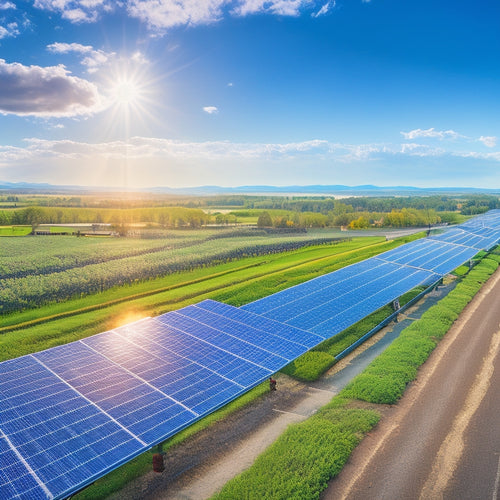
Top Home Power Banks for Emergency Situations
Share
If you're preparing for emergencies, selecting a reliable power bank is vital. Look for units with a minimum capacity of 10,000 mAh to guarantee you can charge essential devices like smartphones and tablets. Consider models like the Anker Powerhouse 200 or Jackery Voyager 500, which offer multiple output ports and fast charging capabilities. Evaluate features such as safety certifications, user-friendly interfaces, and smart charging technology for peak performance. With the right choice, you'll maintain connectivity and functionality during outages. Investigate more power bank options to confirm you've got the best emergency backup at home.
At a Glance
- Choose power banks with a capacity of at least 10,000 mAh for reliable charging during emergencies.
- Look for models with multiple output ports to charge several devices simultaneously.
- Select power banks that feature fast-charging technologies to minimize downtime during power outages.
- Ensure safety certifications like UL or CE are present for safe operation during emergencies.
- Consider portable and lightweight designs for easy transport during travel or evacuation situations.
Reliable Power During Outages
When power outages strike, having a reliable power bank can make all the difference in maintaining essential devices.
Evaluating your energy needs for ideal battery performance is vital to guarantee you choose a power bank that meets your requirements.
You'll want to take into account key features like capacity, output ports, and charging speed to make certain your needs are met during emergencies.
Additionally, exploring the best models available today will help you make an informed decision customized to your specific requirements.
Essential Features to Consider
How can you guarantee your home power bank is reliable during outages? First, look for essential functionalities that meet your specific power needs. A power bank with multiple output ports allows you to charge various devices simultaneously, ensuring you stay connected when it matters most.
Check the wattage capacity; higher wattage means quicker charging and the ability to power larger devices.
Next, prioritize a user-friendly interface. You want a power bank that's easy to operate, especially during stressful situations. Look for features like clear LED indicators that show battery level and charging status. Some models come with smart charging technology, which automatically detects device requirements for peak performance.
Consider the battery type as well. Lithium-ion batteries generally offer better performance and longevity compared to other types.
Best Models Available Today
Choosing the right home power bank can greatly impact your ability to stay powered during outages. With numerous options available, focusing on top brands can simplify your search. Brands like Anker, Jackery, and Goal Zero have consistently received high marks for reliability and performance.
When evaluating models, consider those that provide sufficient wattage to support your essential devices. For instance, the Anker Powerhouse 200 offers 213Wh, making it ideal for charging laptops and small appliances. User reviews praise its compact design and efficient charging capabilities.
Another standout is the Jackery Voyager 500, known for its strong battery life and multiple output ports. Users appreciate its versatility during emergencies, allowing them to power several devices simultaneously.
The Goal Zero Yeti 400 is also worth mentioning, especially for those who prioritize solar compatibility. Its performance during outages has garnered favorable user reviews, highlighting its durability and ease of use.
Convenient Charging Anywhere, Anytime
When you choose a power bank for emergency situations, portability and a lightweight design are essential for easy transport.
These features allow you to charge your devices conveniently, whether you're at home or on the go.
Moreover, ensuring compatibility with multiple devices enhances your ability to stay powered up, regardless of what you need to charge.
In addition, a reliable power bank can serve as a backup power source during emergencies, keeping you connected and safe when it matters most reliable energy source.
Portability and Lightweight Design
With the rise of mobile technology, the demand for portable power solutions has never been greater. You want a power bank that's not just effective but also designed for your on-the-go lifestyle. A compact design is crucial; it allows you to slip the device into your backpack or purse without adding unnecessary bulk.
This travel-friendly feature means you can charge your devices anytime, anywhere, whether you're in a café, at the airport, or during a camping trip.
When selecting a power bank, consider its weight alongside its capacity. A lightweight design guarantees that you won't feel weighed down, especially during long trips. Look for models that balance portability with performance; you don't want to sacrifice charging speed for size.
Additionally, many modern power banks now come equipped with fast-charging capabilities, allowing you to juice up your devices quickly when time is of the essence.
In emergency situations, having a portable power bank can be a breakthrough. It not only keeps your devices running but also grants you the freedom to stay connected, no matter where you are.
Accept the convenience that a well-designed power bank offers.
Multiple Device Compatibility
The convenience of multiple device compatibility in power banks guarantees you can charge various gadgets simultaneously, making them indispensable in emergency situations.
You'll appreciate the flexibility these power banks offer, allowing you to connect device types like smartphones, tablets, and even laptops without hassle. This capability guarantees that you're not limited to a single device, which is essential when every moment counts during an emergency.
Moreover, many modern power banks come equipped with advanced technology, enabling faster charging speeds. This means you can quickly power up multiple devices at once, reducing downtime and keeping you connected when it matters most.
Look for power banks that employ Quick Charge or Power Delivery technology; they can greatly cut charging time compared to standard options.
Additionally, the versatility of multiple ports—USB-A, USB-C, and even AC outlets—makes it easy to accommodate various device types and their specific charging requirements.
You won't have to carry multiple chargers or worry about compatibility issues. Fundamentally, having a power bank with multiple device compatibility provides you the freedom to stay powered up, guaranteeing you can tackle whatever challenges arise during emergencies.
Key Specifications Overview
When selecting a home power bank, understanding its capacity and output power is essential for meeting your energy needs during emergencies.
Evaluating the depth of discharge (DOD) can help determine the maximum usable energy from the power bank.
Additionally, a strong safety features checklist can help guarantee the device operates safely under various conditions.
Let's investigate these specifications to help you choose the right power bank for your situation.
Capacity and Output Power
Understanding capacity and output power is vital for selecting the right home power bank for emergency situations.
Capacity, measured in milliamp-hours (mAh), indicates how much energy the power bank can store. A higher capacity means more stored energy, allowing you to charge multiple devices or larger gadgets like laptops during an outage. For instance, a power bank with 20,000 mAh can recharge a smartphone several times, giving you the freedom to stay connected when it matters most.
Output power, measured in watts (W), determines how quickly your devices can charge. A power bank with a higher output power can charge devices faster, which is essential in emergencies when time is of the essence. Look for power banks that support fast charging technologies, as they can greatly reduce downtime.
Additionally, consider power management features, especially if you plan to use solar charging. Efficient power management guarantees that energy is employed effectively, maximizing the benefits from solar inputs.
In emergencies, you want a power bank that can adapt to various charging methods while providing reliable performance. Choosing wisely based on capacity and output power will help you stay prepared and equipped in critical situations.
Safety Features Checklist
Choosing a power bank for emergency situations requires careful attention to safety features. You need to guarantee that the power bank you select comes equipped with essential safety certifications, like UL, CE, or FCC. These certifications indicate that the device has undergone rigorous testing to meet safety standards, reducing the risk of short circuits, overheating, or even fires during use.
Next, look for built-in protections such as overcharge, over-discharge, and short-circuit prevention. These features safeguard both the power bank and your devices, assuring reliable performance when you need it most.
Additionally, consider a model with temperature control to prevent overheating, which can be vital during extended usage in high-demand situations.
Another significant aspect is the quality of the battery itself. Lithium-polymer batteries are often preferred for their stability and lightweight design.
Finally, check for user-friendly indicators, like LED lights, that inform you of the power bank's charge status.
Incorporating these safety features into your emergency preparedness plan guarantees that you're not only ready for power outages but also protected from potential hazards.
Prioritize safety, and your power bank will serve you well when it matters most.
Selecting Based on Battery Capacity
When selecting a power bank for emergencies, understanding battery capacity ratings is vital. High-capacity options are essential for ensuring that your devices remain operational during extended outages, as they can provide backup power when grid electricity is unavailable.
You'll want to choose a capacity that can adequately meet your needs during an outage, ensuring your devices stay charged when it matters most. Ideally, look for a power bank with at least 10,000 mAh to provide sufficient power for important devices.
For those considering renewable energy solutions, solar battery storage can also be a worthwhile addition to enhance energy independence.
Understanding Battery Capacity Ratings
Battery capacity ratings play an important role in determining how well a power bank can meet your emergency charging needs. These ratings are typically measured in milliampere-hours (mAh) or watt-hours (Wh), providing a clear indication of how much energy the power bank can store.
Understanding these metrics is vital when evaluating different models, especially in relation to battery technology advancements.
When you consider a power bank, a higher mAh or Wh rating generally means longer usage time for your devices. For instance, if you have a smartphone with a 3000mAh battery, a 10000mAh power bank could theoretically charge it roughly three times. However, efficiency losses during charging should also be factored in, as not all energy is transferred effectively due to heat and other factors.
Capacity measurement isn't just about numbers; it's about your freedom during emergencies. A power bank with sufficient capacity guarantees you can keep essential devices operational, enabling communication and access to information.
Always evaluate your specific needs and the compatibility of the power bank to maximize its potential in significant situations.
Ideal Capacity for Emergencies
For emergency situations, selecting a power bank with the ideal capacity hinges on evaluating your device usage and the expected duration of a power outage. Understanding your emergency needs is essential. Consider how long you might be without power and what devices you'll need to charge—smartphones, tablets, or even portable Wi-Fi routers.
Here's a simple breakdown to help you choose the right capacity based on your power requirements:
| Device Type | Average Battery Capacity (mAh) | Recommended Power Bank Capacity (mAh) |
|---|---|---|
| Smartphone | 3,000 - 4,000 | 10,000 - 20,000 |
| Tablet | 6,000 - 8,000 | 20,000 - 30,000 |
| Portable Wi-Fi | 2,500 - 5,000 | 10,000 - 15,000 |
If you anticipate longer outages, opt for a power bank with higher capacity. A well-chosen power bank guarantees you can stay connected and informed during emergencies, granting you the freedom to steer through uncertain times with confidence.
Long-Lasting Battery Performance
When considering long-lasting battery performance, you need to evaluate the battery capacity of your power bank.
Higher capacity means more stored energy, which translates to longer usage times during emergencies.
It's crucial to balance capacity with the size and weight of the unit to guarantee it meets your needs effectively.
Battery Capacity Considerations
Understanding battery capacity is essential for ensuring your home power bank performs effectively during emergencies. The capacity of a power bank, typically measured in milliampere-hours (mAh), directly influences how many devices you can charge and for how long.
However, there are several capacity myths that can mislead you. For instance, higher mAh ratings don't always equate to better performance. Factors like battery technology and discharge rates play critical roles in actual usability.
When choosing a power bank, consider not just the capacity but also the efficiency of the battery technology used. Lithium-ion batteries, for instance, offer a higher energy density compared to older technologies, meaning they can store more energy in a smaller footprint. This efficiency translates into longer-lasting performance during emergencies.
Additionally, you should assess your device's power requirements. A power bank with a capacity of 10,000 mAh may seem sufficient, but if you're charging a high-demand device, it could deplete quickly.
Always calculate your needs based on usage patterns. By understanding these elements, you equip yourself to choose a reliable power bank that meets your emergency preparedness goals.
Frequently Asked Questions
Can I Use a Power Bank to Charge My Laptop?
Yes, you can use a power bank to charge your laptop, but verify its compatibility with your device. Consider charging speed too; a higher wattage power bank will deliver faster, more efficient power for your laptop.
How Long Does It Take to Fully Charge a Power Bank?
Charging speed varies based on your power bank capacity and input power. Generally, a high-capacity power bank takes around 4 to 8 hours to fully charge, but faster options can reduce this time considerably.
Are There Safety Features in Power Banks?
Yes, most power banks include essential safety features like overheating protection and surge protection. These mechanisms guarantee your devices charge safely, preventing damage from excessive heat or voltage spikes, giving you peace of mind during use.
Can Power Banks Charge Multiple Devices Simultaneously?
Yes, many power banks can charge multiple devices simultaneously. The power bank capacity and charging speed determine how efficiently it manages energy distribution, ensuring reliable performance for your devices, even under demanding circumstances.
What Is the Shelf Life of a Power Bank?
When it comes to the shelf life of a power bank, you'll want to keep it in good shape. With proper power bank maintenance, you can guarantee ideal charging efficiency for about 2 to 3 years.
Explore More
In uncertain times, having a reliable power bank can make all the difference. Whether you're facing an outage or simply need to keep your devices charged on the go, the right power bank guarantees you're prepared. With various capacities and features available, why settle for anything less than the best? By choosing a power bank that meets your specific needs, you'll enjoy peace of mind knowing you're equipped to handle any emergency situation effectively.
Related Posts
-

Smart Home Thermostats to Revolutionize Your Space
Smart home thermostats revolutionize your space by providing precise temperature control and optimizing energy saving...
-

Applications of Photovoltaic Systems
Photovoltaic systems are versatile, converting sunlight into electricity for various applications. You can use them i...
-

Cost of Solar With Battery Backup
You're investing in a solar panel system with battery backup to guarantee reliable power during outages. The cost of ...


